Water, Migration, and Development
The calculations are performed using the empirical estimation described in box 2.5 in combination with summary measures of forest loss and irrigation costs. Globally, on average, for a 10 percentage point decrease in the share of forest cover,14 around 195 million hectares of land would need to be placed under irrigation to compensate for the drought-buffering effects of lost forest. At a unit cost of irrigation expansion ranging from US$4,000 to US$16,000 per hectare (Inocencio et al. 2007), this would mean an investment cost of about US$0.8 trillion to US$3 trillion. These estimates show that the drought-buffering effects of forests are not trivial and highlight the underappreciated benefits of investing in forests and nature. Healthy ecosystems underpin economies and society on many levels. They provide essential livelihoods and environmental services, regulate key aspects of the global carbon cycle and climate, sustain cultural traditions, and offer health and recreation benefits. They also provide critical habitat for biodiversity. Although a comprehensive accounting of all of the benefits remains elusive, the costs of nature-based solutions are often found to be negligible and without large financial outlays or environmental damage, compared with other physical capital. Elsewhere, studies have shown that preserving floodplains from development can reduce flood damage by up to 78 percent, and using environmentally sensitive agricultural and land management practices can increase water flow by up to 11 percent (Watson et al. 2016; Abell et al. 2017). Importantly, natural capital investments can be complementary to infrastructure. Investing in a suite of solutions to buffer incomes from erratic rains—for example, protecting catchment areas and forests, together with a canal or dam for irrigation—can produce greater benefits than investing in any single one of these solutions (Guannel et al. 2016).
WATER AS A CONDUIT FOR DEVELOPMENT Much of the study of development economics is concerned with why some places are poor and some are rich, which is closely related to why some places became rich and some remained poor. Underpinning this foundational question in development is the unfolding process of migration. It is the key channel through which standards of living can even out across regions such that people can take advantage of new opportunities and leave areas hit by economic adversity. This chapter uses historical episodes of water shocks and their relation to migration to better understand water’s role in shaping the issues related to this central theme within economics. It demonstrates that migration serves as a significant margin of adjustment in response to water shocks and persistent droughts. But it also highlights that this adjustment mechanism may not be available to everyone. Even as a closer study of economic incentives might predict movement in response to differences in economic opportunities
66



